MSc BIM: Analysis of Project Execution and Collaboration
VerifiedAdded on 2020/10/23
|14
|3487
|294
Report
AI Summary
This report provides a comprehensive analysis of Building Information Modelling (BIM) within the context of project execution and collaboration. The report begins with an introduction to BIM as an intelligent 3D model and its significance in architecture, construction, and engineering. It then critically analyzes the project execution, focusing on collaboration relationships and their influences, particularly highlighting how BIM facilitates collaboration among stakeholders. The report explores various methods, processes, and technologies, including the use of Revit Structure and the creation of new building modeling objects, like geometric models and reinforcement designs. The study also delves into the application of BIM for measurements, costs, and quantities, emphasizing its role in optimizing the design process and improving project quality. Furthermore, the report examines the production and presentation of project materials and artifacts, detailing how BIM influences the perception and delivery of construction projects. The report concludes by summarizing the key findings and implications of BIM in modern construction practices, offering insights into its benefits and challenges.
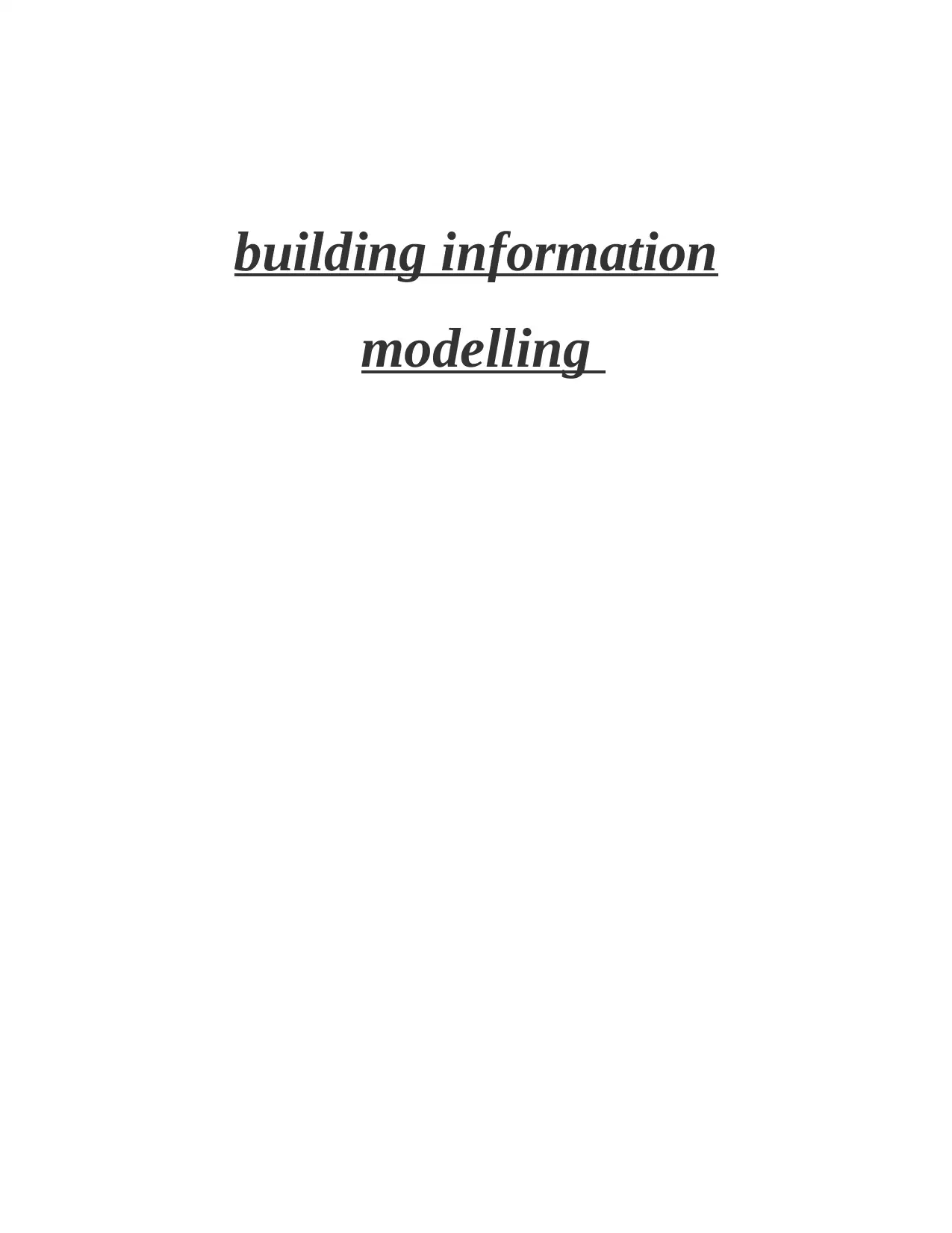
building information
modelling
modelling
Paraphrase This Document
Need a fresh take? Get an instant paraphrase of this document with our AI Paraphraser
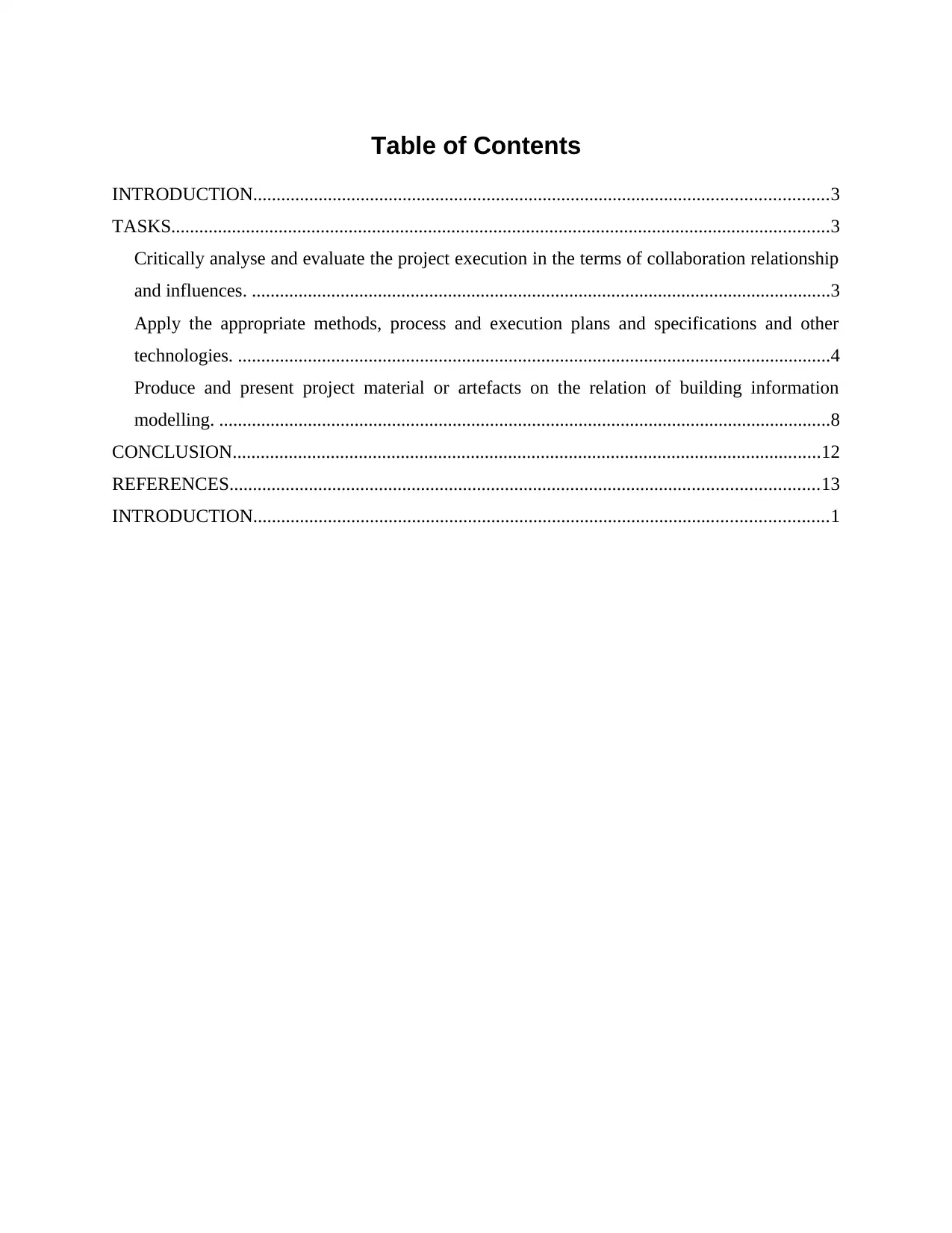
Table of Contents
INTRODUCTION...........................................................................................................................3
TASKS.............................................................................................................................................3
Critically analyse and evaluate the project execution in the terms of collaboration relationship
and influences. ............................................................................................................................3
Apply the appropriate methods, process and execution plans and specifications and other
technologies. ...............................................................................................................................4
Produce and present project material or artefacts on the relation of building information
modelling. ...................................................................................................................................8
CONCLUSION..............................................................................................................................12
REFERENCES..............................................................................................................................13
INTRODUCTION...........................................................................................................................1
INTRODUCTION...........................................................................................................................3
TASKS.............................................................................................................................................3
Critically analyse and evaluate the project execution in the terms of collaboration relationship
and influences. ............................................................................................................................3
Apply the appropriate methods, process and execution plans and specifications and other
technologies. ...............................................................................................................................4
Produce and present project material or artefacts on the relation of building information
modelling. ...................................................................................................................................8
CONCLUSION..............................................................................................................................12
REFERENCES..............................................................................................................................13
INTRODUCTION...........................................................................................................................1
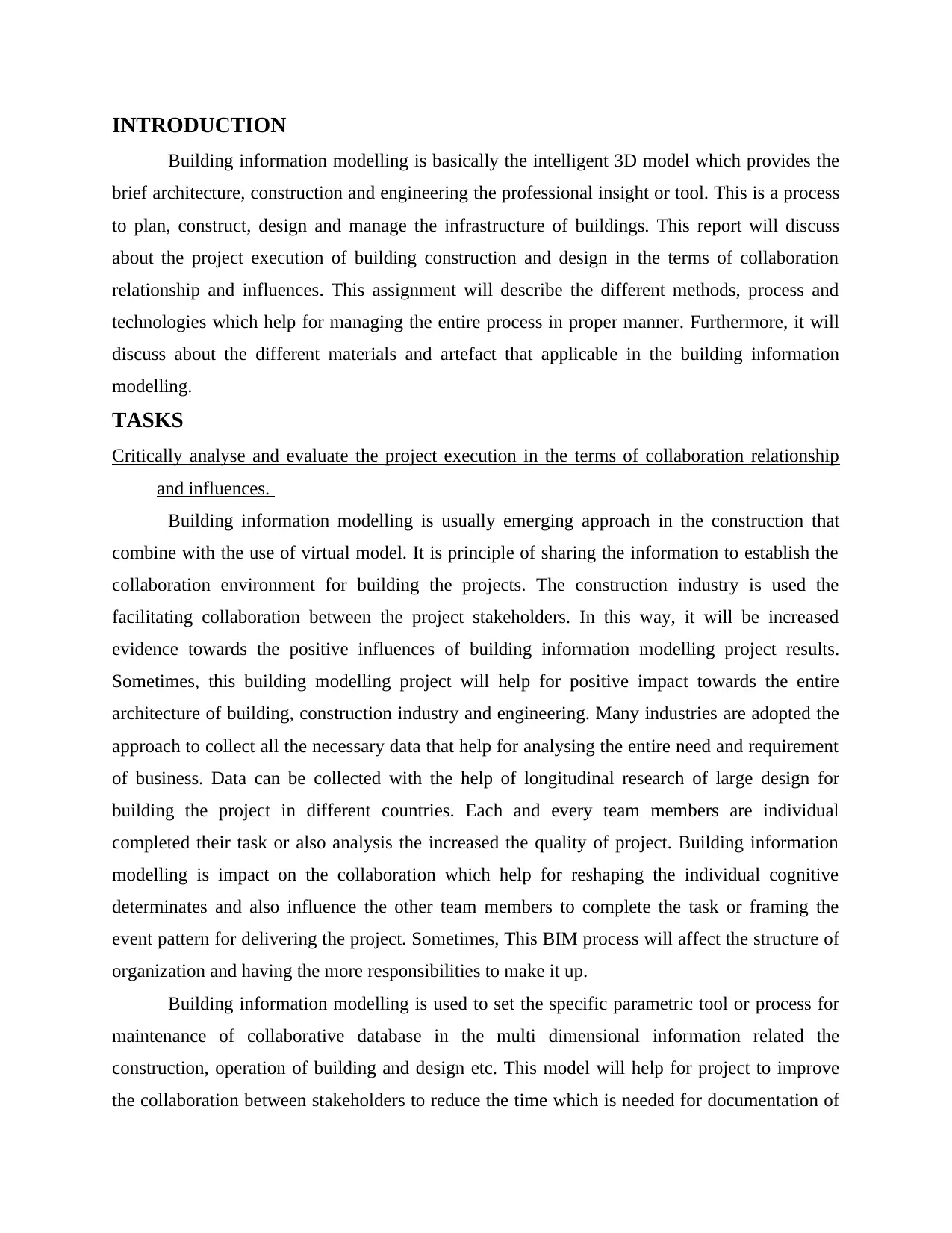
INTRODUCTION
Building information modelling is basically the intelligent 3D model which provides the
brief architecture, construction and engineering the professional insight or tool. This is a process
to plan, construct, design and manage the infrastructure of buildings. This report will discuss
about the project execution of building construction and design in the terms of collaboration
relationship and influences. This assignment will describe the different methods, process and
technologies which help for managing the entire process in proper manner. Furthermore, it will
discuss about the different materials and artefact that applicable in the building information
modelling.
TASKS
Critically analyse and evaluate the project execution in the terms of collaboration relationship
and influences.
Building information modelling is usually emerging approach in the construction that
combine with the use of virtual model. It is principle of sharing the information to establish the
collaboration environment for building the projects. The construction industry is used the
facilitating collaboration between the project stakeholders. In this way, it will be increased
evidence towards the positive influences of building information modelling project results.
Sometimes, this building modelling project will help for positive impact towards the entire
architecture of building, construction industry and engineering. Many industries are adopted the
approach to collect all the necessary data that help for analysing the entire need and requirement
of business. Data can be collected with the help of longitudinal research of large design for
building the project in different countries. Each and every team members are individual
completed their task or also analysis the increased the quality of project. Building information
modelling is impact on the collaboration which help for reshaping the individual cognitive
determinates and also influence the other team members to complete the task or framing the
event pattern for delivering the project. Sometimes, This BIM process will affect the structure of
organization and having the more responsibilities to make it up.
Building information modelling is used to set the specific parametric tool or process for
maintenance of collaborative database in the multi dimensional information related the
construction, operation of building and design etc. This model will help for project to improve
the collaboration between stakeholders to reduce the time which is needed for documentation of
Building information modelling is basically the intelligent 3D model which provides the
brief architecture, construction and engineering the professional insight or tool. This is a process
to plan, construct, design and manage the infrastructure of buildings. This report will discuss
about the project execution of building construction and design in the terms of collaboration
relationship and influences. This assignment will describe the different methods, process and
technologies which help for managing the entire process in proper manner. Furthermore, it will
discuss about the different materials and artefact that applicable in the building information
modelling.
TASKS
Critically analyse and evaluate the project execution in the terms of collaboration relationship
and influences.
Building information modelling is usually emerging approach in the construction that
combine with the use of virtual model. It is principle of sharing the information to establish the
collaboration environment for building the projects. The construction industry is used the
facilitating collaboration between the project stakeholders. In this way, it will be increased
evidence towards the positive influences of building information modelling project results.
Sometimes, this building modelling project will help for positive impact towards the entire
architecture of building, construction industry and engineering. Many industries are adopted the
approach to collect all the necessary data that help for analysing the entire need and requirement
of business. Data can be collected with the help of longitudinal research of large design for
building the project in different countries. Each and every team members are individual
completed their task or also analysis the increased the quality of project. Building information
modelling is impact on the collaboration which help for reshaping the individual cognitive
determinates and also influence the other team members to complete the task or framing the
event pattern for delivering the project. Sometimes, This BIM process will affect the structure of
organization and having the more responsibilities to make it up.
Building information modelling is used to set the specific parametric tool or process for
maintenance of collaborative database in the multi dimensional information related the
construction, operation of building and design etc. This model will help for project to improve
the collaboration between stakeholders to reduce the time which is needed for documentation of
⊘ This is a preview!⊘
Do you want full access?
Subscribe today to unlock all pages.

Trusted by 1+ million students worldwide
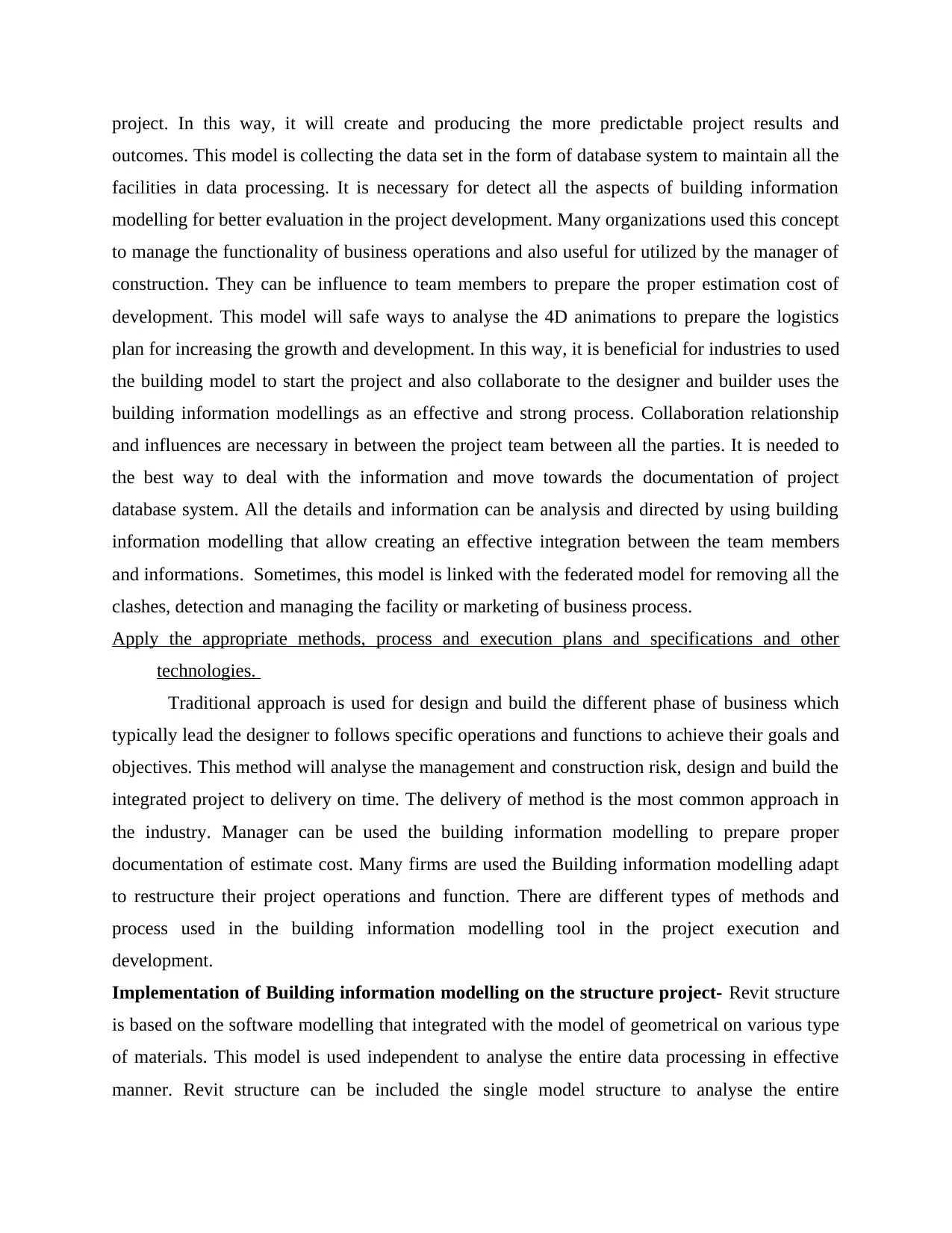
project. In this way, it will create and producing the more predictable project results and
outcomes. This model is collecting the data set in the form of database system to maintain all the
facilities in data processing. It is necessary for detect all the aspects of building information
modelling for better evaluation in the project development. Many organizations used this concept
to manage the functionality of business operations and also useful for utilized by the manager of
construction. They can be influence to team members to prepare the proper estimation cost of
development. This model will safe ways to analyse the 4D animations to prepare the logistics
plan for increasing the growth and development. In this way, it is beneficial for industries to used
the building model to start the project and also collaborate to the designer and builder uses the
building information modellings as an effective and strong process. Collaboration relationship
and influences are necessary in between the project team between all the parties. It is needed to
the best way to deal with the information and move towards the documentation of project
database system. All the details and information can be analysis and directed by using building
information modelling that allow creating an effective integration between the team members
and informations. Sometimes, this model is linked with the federated model for removing all the
clashes, detection and managing the facility or marketing of business process.
Apply the appropriate methods, process and execution plans and specifications and other
technologies.
Traditional approach is used for design and build the different phase of business which
typically lead the designer to follows specific operations and functions to achieve their goals and
objectives. This method will analyse the management and construction risk, design and build the
integrated project to delivery on time. The delivery of method is the most common approach in
the industry. Manager can be used the building information modelling to prepare proper
documentation of estimate cost. Many firms are used the Building information modelling adapt
to restructure their project operations and function. There are different types of methods and
process used in the building information modelling tool in the project execution and
development.
Implementation of Building information modelling on the structure project- Revit structure
is based on the software modelling that integrated with the model of geometrical on various type
of materials. This model is used independent to analyse the entire data processing in effective
manner. Revit structure can be included the single model structure to analyse the entire
outcomes. This model is collecting the data set in the form of database system to maintain all the
facilities in data processing. It is necessary for detect all the aspects of building information
modelling for better evaluation in the project development. Many organizations used this concept
to manage the functionality of business operations and also useful for utilized by the manager of
construction. They can be influence to team members to prepare the proper estimation cost of
development. This model will safe ways to analyse the 4D animations to prepare the logistics
plan for increasing the growth and development. In this way, it is beneficial for industries to used
the building model to start the project and also collaborate to the designer and builder uses the
building information modellings as an effective and strong process. Collaboration relationship
and influences are necessary in between the project team between all the parties. It is needed to
the best way to deal with the information and move towards the documentation of project
database system. All the details and information can be analysis and directed by using building
information modelling that allow creating an effective integration between the team members
and informations. Sometimes, this model is linked with the federated model for removing all the
clashes, detection and managing the facility or marketing of business process.
Apply the appropriate methods, process and execution plans and specifications and other
technologies.
Traditional approach is used for design and build the different phase of business which
typically lead the designer to follows specific operations and functions to achieve their goals and
objectives. This method will analyse the management and construction risk, design and build the
integrated project to delivery on time. The delivery of method is the most common approach in
the industry. Manager can be used the building information modelling to prepare proper
documentation of estimate cost. Many firms are used the Building information modelling adapt
to restructure their project operations and function. There are different types of methods and
process used in the building information modelling tool in the project execution and
development.
Implementation of Building information modelling on the structure project- Revit structure
is based on the software modelling that integrated with the model of geometrical on various type
of materials. This model is used independent to analyse the entire data processing in effective
manner. Revit structure can be included the single model structure to analyse the entire
Paraphrase This Document
Need a fresh take? Get an instant paraphrase of this document with our AI Paraphraser
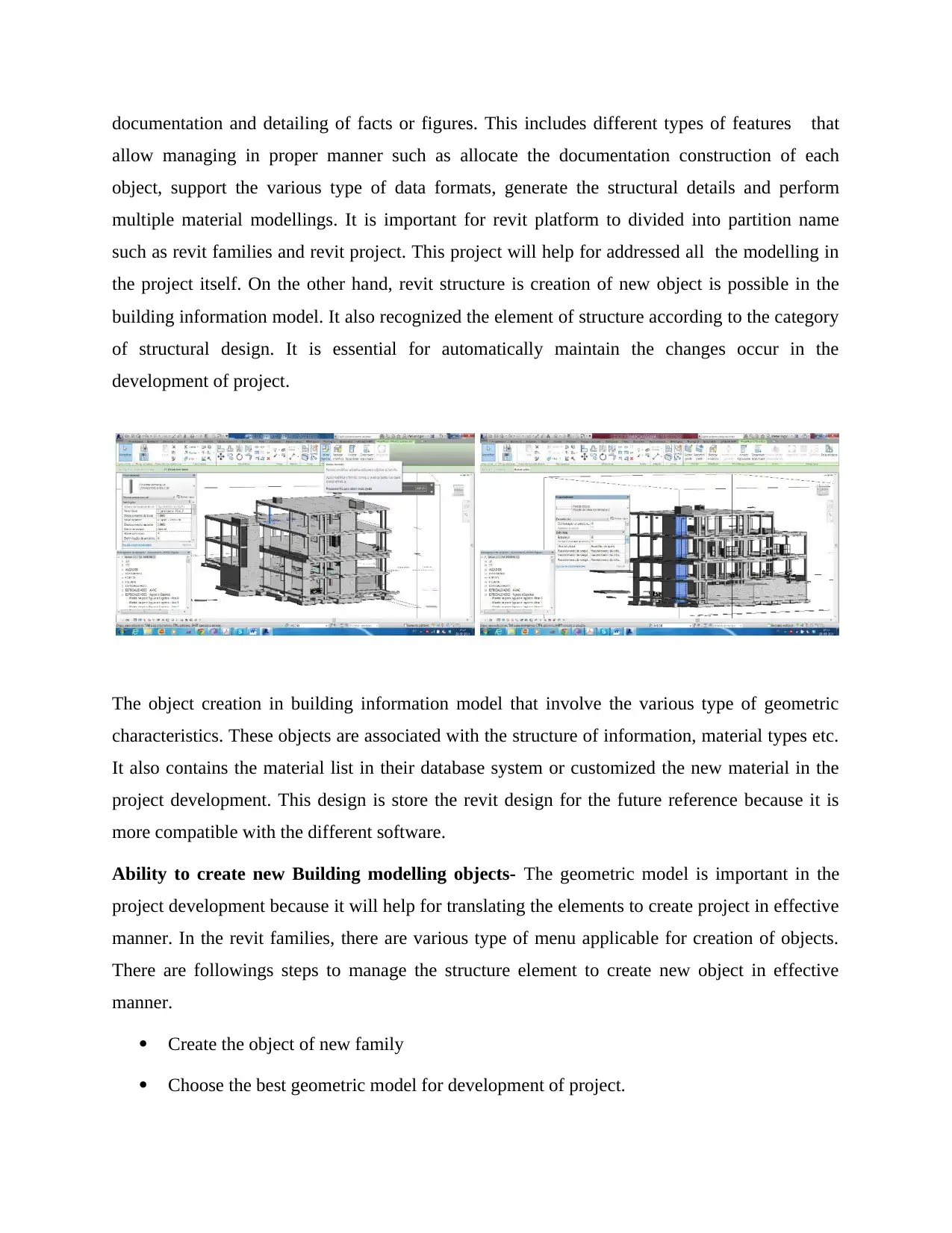
documentation and detailing of facts or figures. This includes different types of features that
allow managing in proper manner such as allocate the documentation construction of each
object, support the various type of data formats, generate the structural details and perform
multiple material modellings. It is important for revit platform to divided into partition name
such as revit families and revit project. This project will help for addressed all the modelling in
the project itself. On the other hand, revit structure is creation of new object is possible in the
building information model. It also recognized the element of structure according to the category
of structural design. It is essential for automatically maintain the changes occur in the
development of project.
The object creation in building information model that involve the various type of geometric
characteristics. These objects are associated with the structure of information, material types etc.
It also contains the material list in their database system or customized the new material in the
project development. This design is store the revit design for the future reference because it is
more compatible with the different software.
Ability to create new Building modelling objects- The geometric model is important in the
project development because it will help for translating the elements to create project in effective
manner. In the revit families, there are various type of menu applicable for creation of objects.
There are followings steps to manage the structure element to create new object in effective
manner.
Create the object of new family
Choose the best geometric model for development of project.
allow managing in proper manner such as allocate the documentation construction of each
object, support the various type of data formats, generate the structural details and perform
multiple material modellings. It is important for revit platform to divided into partition name
such as revit families and revit project. This project will help for addressed all the modelling in
the project itself. On the other hand, revit structure is creation of new object is possible in the
building information model. It also recognized the element of structure according to the category
of structural design. It is essential for automatically maintain the changes occur in the
development of project.
The object creation in building information model that involve the various type of geometric
characteristics. These objects are associated with the structure of information, material types etc.
It also contains the material list in their database system or customized the new material in the
project development. This design is store the revit design for the future reference because it is
more compatible with the different software.
Ability to create new Building modelling objects- The geometric model is important in the
project development because it will help for translating the elements to create project in effective
manner. In the revit families, there are various type of menu applicable for creation of objects.
There are followings steps to manage the structure element to create new object in effective
manner.
Create the object of new family
Choose the best geometric model for development of project.
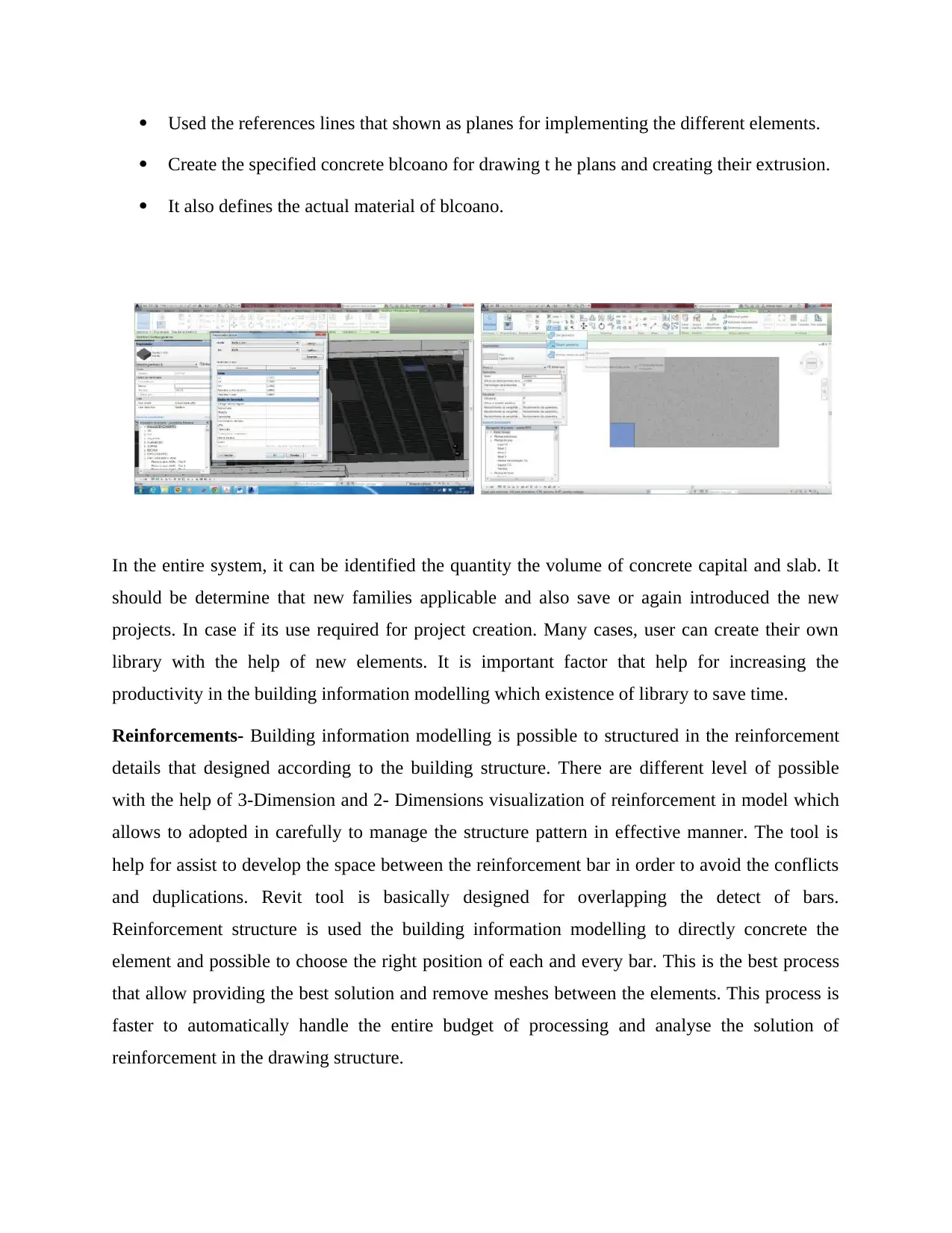
Used the references lines that shown as planes for implementing the different elements.
Create the specified concrete blcoano for drawing t he plans and creating their extrusion.
It also defines the actual material of blcoano.
In the entire system, it can be identified the quantity the volume of concrete capital and slab. It
should be determine that new families applicable and also save or again introduced the new
projects. In case if its use required for project creation. Many cases, user can create their own
library with the help of new elements. It is important factor that help for increasing the
productivity in the building information modelling which existence of library to save time.
Reinforcements- Building information modelling is possible to structured in the reinforcement
details that designed according to the building structure. There are different level of possible
with the help of 3-Dimension and 2- Dimensions visualization of reinforcement in model which
allows to adopted in carefully to manage the structure pattern in effective manner. The tool is
help for assist to develop the space between the reinforcement bar in order to avoid the conflicts
and duplications. Revit tool is basically designed for overlapping the detect of bars.
Reinforcement structure is used the building information modelling to directly concrete the
element and possible to choose the right position of each and every bar. This is the best process
that allow providing the best solution and remove meshes between the elements. This process is
faster to automatically handle the entire budget of processing and analyse the solution of
reinforcement in the drawing structure.
Create the specified concrete blcoano for drawing t he plans and creating their extrusion.
It also defines the actual material of blcoano.
In the entire system, it can be identified the quantity the volume of concrete capital and slab. It
should be determine that new families applicable and also save or again introduced the new
projects. In case if its use required for project creation. Many cases, user can create their own
library with the help of new elements. It is important factor that help for increasing the
productivity in the building information modelling which existence of library to save time.
Reinforcements- Building information modelling is possible to structured in the reinforcement
details that designed according to the building structure. There are different level of possible
with the help of 3-Dimension and 2- Dimensions visualization of reinforcement in model which
allows to adopted in carefully to manage the structure pattern in effective manner. The tool is
help for assist to develop the space between the reinforcement bar in order to avoid the conflicts
and duplications. Revit tool is basically designed for overlapping the detect of bars.
Reinforcement structure is used the building information modelling to directly concrete the
element and possible to choose the right position of each and every bar. This is the best process
that allow providing the best solution and remove meshes between the elements. This process is
faster to automatically handle the entire budget of processing and analyse the solution of
reinforcement in the drawing structure.
⊘ This is a preview!⊘
Do you want full access?
Subscribe today to unlock all pages.

Trusted by 1+ million students worldwide
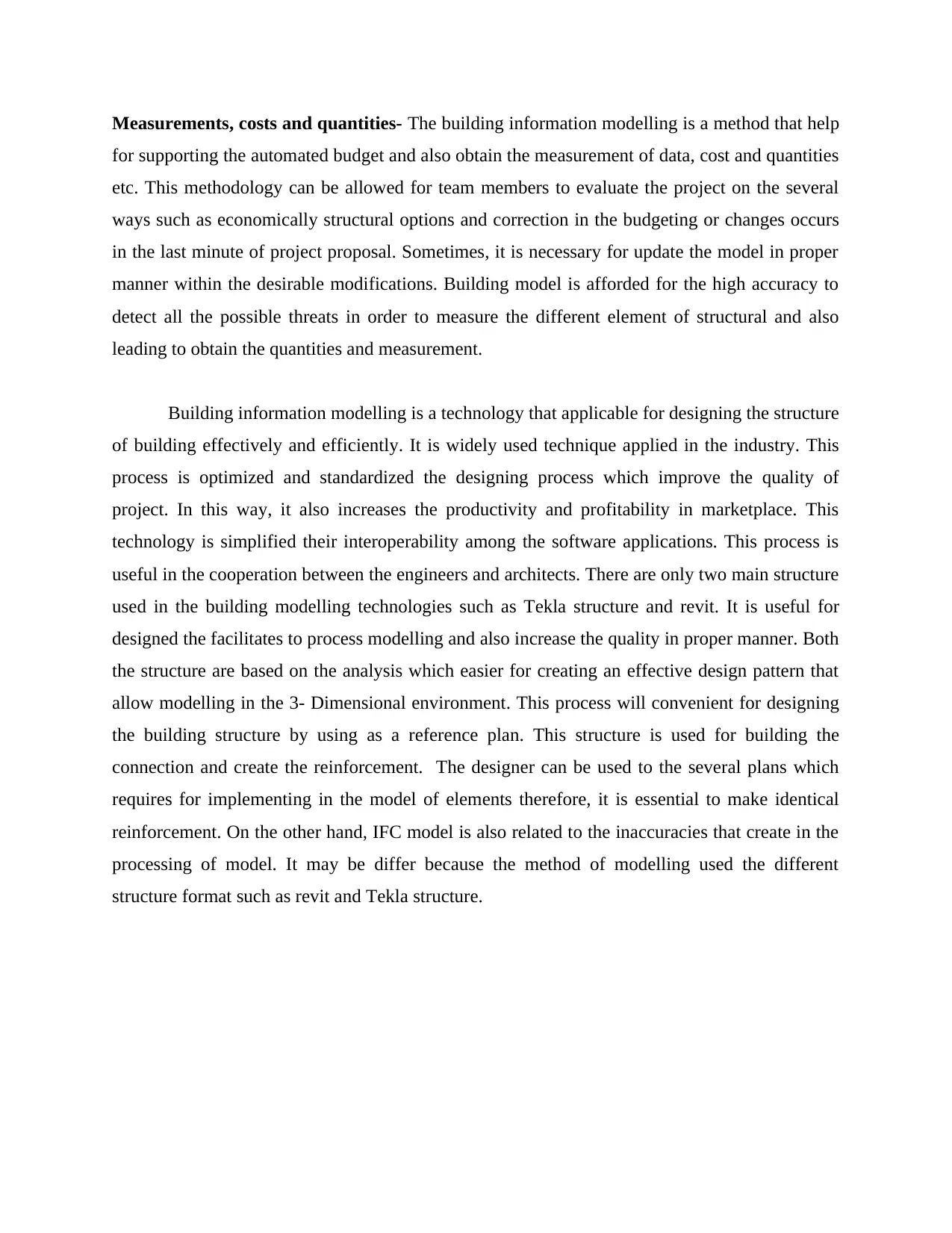
Measurements, costs and quantities- The building information modelling is a method that help
for supporting the automated budget and also obtain the measurement of data, cost and quantities
etc. This methodology can be allowed for team members to evaluate the project on the several
ways such as economically structural options and correction in the budgeting or changes occurs
in the last minute of project proposal. Sometimes, it is necessary for update the model in proper
manner within the desirable modifications. Building model is afforded for the high accuracy to
detect all the possible threats in order to measure the different element of structural and also
leading to obtain the quantities and measurement.
Building information modelling is a technology that applicable for designing the structure
of building effectively and efficiently. It is widely used technique applied in the industry. This
process is optimized and standardized the designing process which improve the quality of
project. In this way, it also increases the productivity and profitability in marketplace. This
technology is simplified their interoperability among the software applications. This process is
useful in the cooperation between the engineers and architects. There are only two main structure
used in the building modelling technologies such as Tekla structure and revit. It is useful for
designed the facilitates to process modelling and also increase the quality in proper manner. Both
the structure are based on the analysis which easier for creating an effective design pattern that
allow modelling in the 3- Dimensional environment. This process will convenient for designing
the building structure by using as a reference plan. This structure is used for building the
connection and create the reinforcement. The designer can be used to the several plans which
requires for implementing in the model of elements therefore, it is essential to make identical
reinforcement. On the other hand, IFC model is also related to the inaccuracies that create in the
processing of model. It may be differ because the method of modelling used the different
structure format such as revit and Tekla structure.
for supporting the automated budget and also obtain the measurement of data, cost and quantities
etc. This methodology can be allowed for team members to evaluate the project on the several
ways such as economically structural options and correction in the budgeting or changes occurs
in the last minute of project proposal. Sometimes, it is necessary for update the model in proper
manner within the desirable modifications. Building model is afforded for the high accuracy to
detect all the possible threats in order to measure the different element of structural and also
leading to obtain the quantities and measurement.
Building information modelling is a technology that applicable for designing the structure
of building effectively and efficiently. It is widely used technique applied in the industry. This
process is optimized and standardized the designing process which improve the quality of
project. In this way, it also increases the productivity and profitability in marketplace. This
technology is simplified their interoperability among the software applications. This process is
useful in the cooperation between the engineers and architects. There are only two main structure
used in the building modelling technologies such as Tekla structure and revit. It is useful for
designed the facilitates to process modelling and also increase the quality in proper manner. Both
the structure are based on the analysis which easier for creating an effective design pattern that
allow modelling in the 3- Dimensional environment. This process will convenient for designing
the building structure by using as a reference plan. This structure is used for building the
connection and create the reinforcement. The designer can be used to the several plans which
requires for implementing in the model of elements therefore, it is essential to make identical
reinforcement. On the other hand, IFC model is also related to the inaccuracies that create in the
processing of model. It may be differ because the method of modelling used the different
structure format such as revit and Tekla structure.
Paraphrase This Document
Need a fresh take? Get an instant paraphrase of this document with our AI Paraphraser
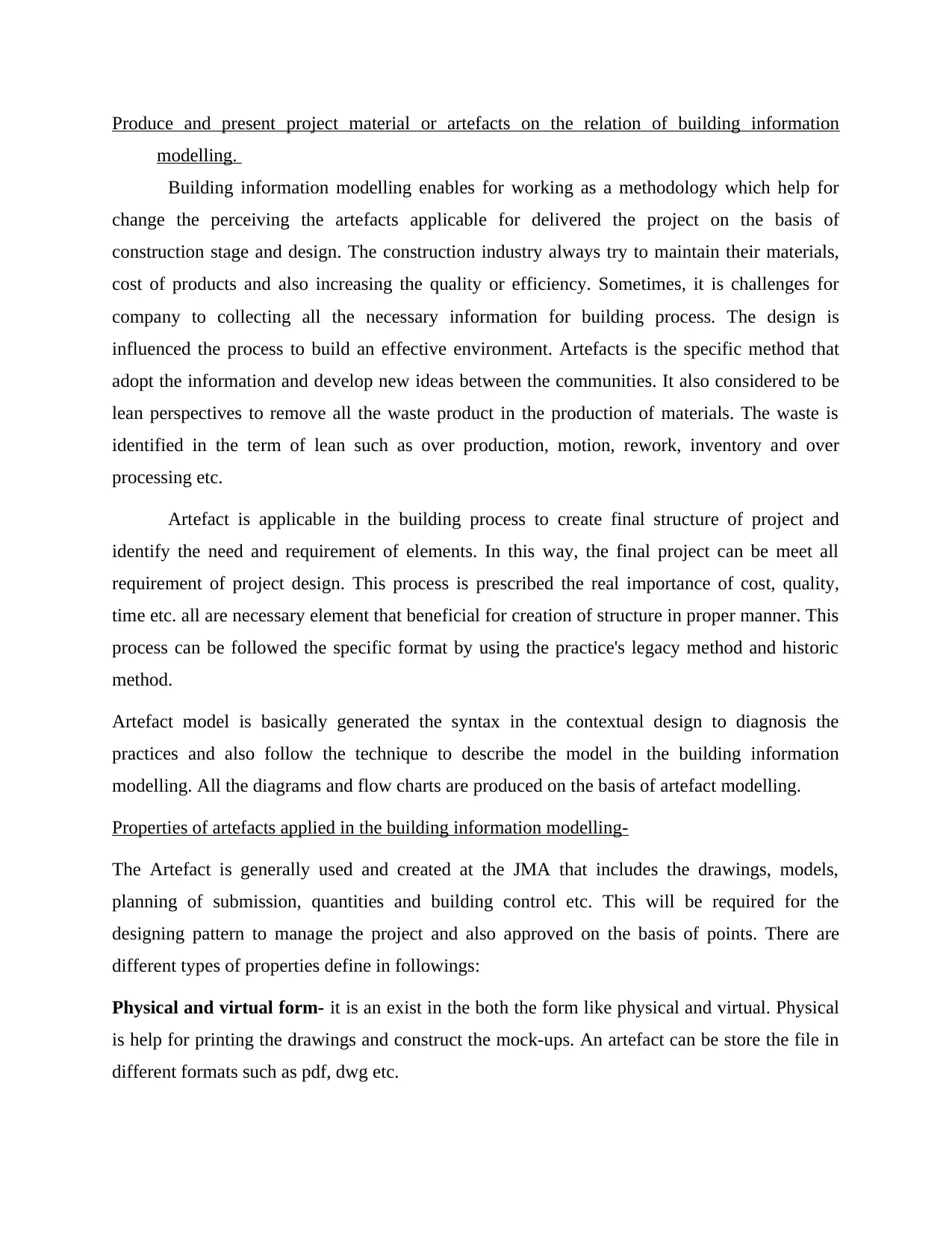
Produce and present project material or artefacts on the relation of building information
modelling.
Building information modelling enables for working as a methodology which help for
change the perceiving the artefacts applicable for delivered the project on the basis of
construction stage and design. The construction industry always try to maintain their materials,
cost of products and also increasing the quality or efficiency. Sometimes, it is challenges for
company to collecting all the necessary information for building process. The design is
influenced the process to build an effective environment. Artefacts is the specific method that
adopt the information and develop new ideas between the communities. It also considered to be
lean perspectives to remove all the waste product in the production of materials. The waste is
identified in the term of lean such as over production, motion, rework, inventory and over
processing etc.
Artefact is applicable in the building process to create final structure of project and
identify the need and requirement of elements. In this way, the final project can be meet all
requirement of project design. This process is prescribed the real importance of cost, quality,
time etc. all are necessary element that beneficial for creation of structure in proper manner. This
process can be followed the specific format by using the practice's legacy method and historic
method.
Artefact model is basically generated the syntax in the contextual design to diagnosis the
practices and also follow the technique to describe the model in the building information
modelling. All the diagrams and flow charts are produced on the basis of artefact modelling.
Properties of artefacts applied in the building information modelling-
The Artefact is generally used and created at the JMA that includes the drawings, models,
planning of submission, quantities and building control etc. This will be required for the
designing pattern to manage the project and also approved on the basis of points. There are
different types of properties define in followings:
Physical and virtual form- it is an exist in the both the form like physical and virtual. Physical
is help for printing the drawings and construct the mock-ups. An artefact can be store the file in
different formats such as pdf, dwg etc.
modelling.
Building information modelling enables for working as a methodology which help for
change the perceiving the artefacts applicable for delivered the project on the basis of
construction stage and design. The construction industry always try to maintain their materials,
cost of products and also increasing the quality or efficiency. Sometimes, it is challenges for
company to collecting all the necessary information for building process. The design is
influenced the process to build an effective environment. Artefacts is the specific method that
adopt the information and develop new ideas between the communities. It also considered to be
lean perspectives to remove all the waste product in the production of materials. The waste is
identified in the term of lean such as over production, motion, rework, inventory and over
processing etc.
Artefact is applicable in the building process to create final structure of project and
identify the need and requirement of elements. In this way, the final project can be meet all
requirement of project design. This process is prescribed the real importance of cost, quality,
time etc. all are necessary element that beneficial for creation of structure in proper manner. This
process can be followed the specific format by using the practice's legacy method and historic
method.
Artefact model is basically generated the syntax in the contextual design to diagnosis the
practices and also follow the technique to describe the model in the building information
modelling. All the diagrams and flow charts are produced on the basis of artefact modelling.
Properties of artefacts applied in the building information modelling-
The Artefact is generally used and created at the JMA that includes the drawings, models,
planning of submission, quantities and building control etc. This will be required for the
designing pattern to manage the project and also approved on the basis of points. There are
different types of properties define in followings:
Physical and virtual form- it is an exist in the both the form like physical and virtual. Physical
is help for printing the drawings and construct the mock-ups. An artefact can be store the file in
different formats such as pdf, dwg etc.
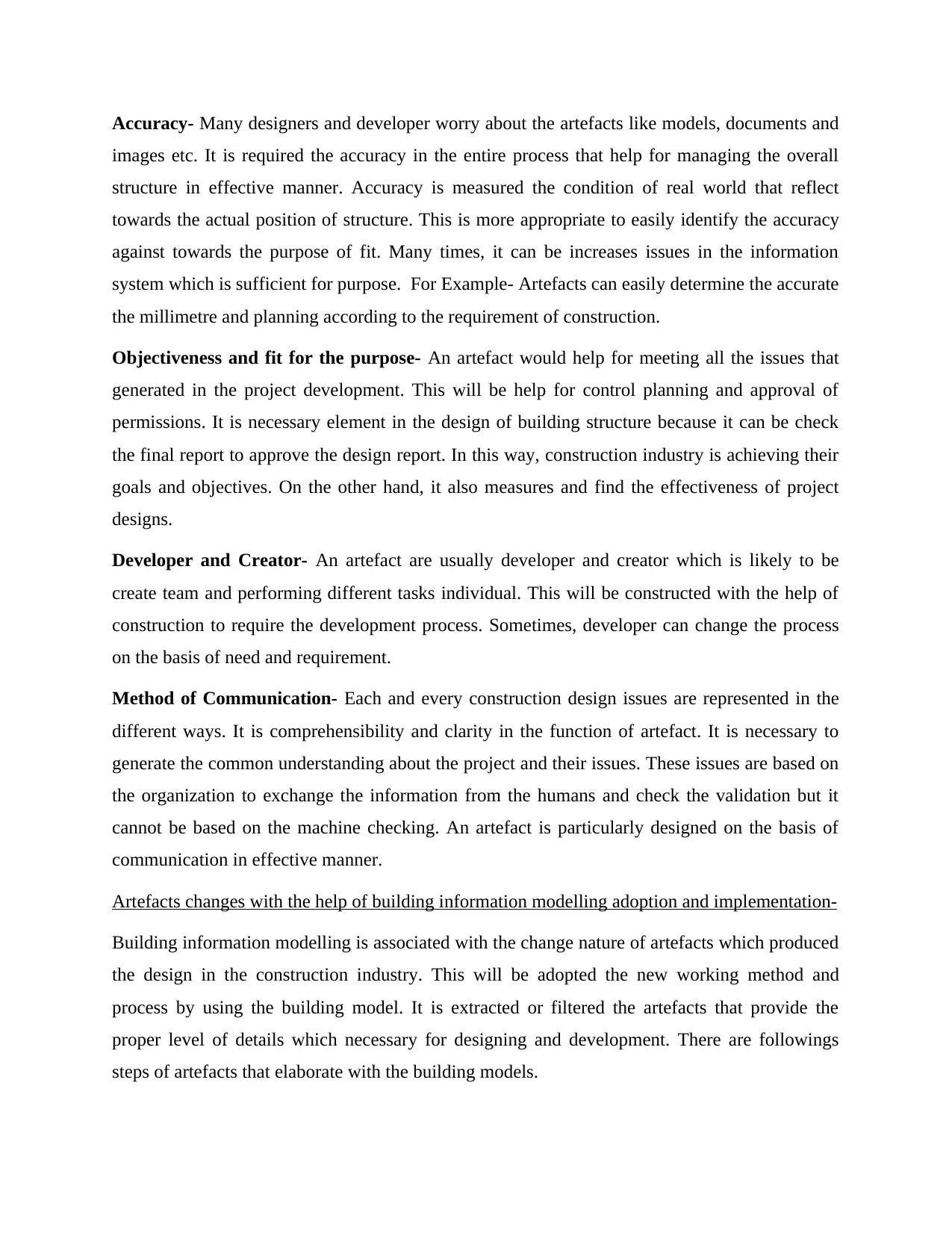
Accuracy- Many designers and developer worry about the artefacts like models, documents and
images etc. It is required the accuracy in the entire process that help for managing the overall
structure in effective manner. Accuracy is measured the condition of real world that reflect
towards the actual position of structure. This is more appropriate to easily identify the accuracy
against towards the purpose of fit. Many times, it can be increases issues in the information
system which is sufficient for purpose. For Example- Artefacts can easily determine the accurate
the millimetre and planning according to the requirement of construction.
Objectiveness and fit for the purpose- An artefact would help for meeting all the issues that
generated in the project development. This will be help for control planning and approval of
permissions. It is necessary element in the design of building structure because it can be check
the final report to approve the design report. In this way, construction industry is achieving their
goals and objectives. On the other hand, it also measures and find the effectiveness of project
designs.
Developer and Creator- An artefact are usually developer and creator which is likely to be
create team and performing different tasks individual. This will be constructed with the help of
construction to require the development process. Sometimes, developer can change the process
on the basis of need and requirement.
Method of Communication- Each and every construction design issues are represented in the
different ways. It is comprehensibility and clarity in the function of artefact. It is necessary to
generate the common understanding about the project and their issues. These issues are based on
the organization to exchange the information from the humans and check the validation but it
cannot be based on the machine checking. An artefact is particularly designed on the basis of
communication in effective manner.
Artefacts changes with the help of building information modelling adoption and implementation-
Building information modelling is associated with the change nature of artefacts which produced
the design in the construction industry. This will be adopted the new working method and
process by using the building model. It is extracted or filtered the artefacts that provide the
proper level of details which necessary for designing and development. There are followings
steps of artefacts that elaborate with the building models.
images etc. It is required the accuracy in the entire process that help for managing the overall
structure in effective manner. Accuracy is measured the condition of real world that reflect
towards the actual position of structure. This is more appropriate to easily identify the accuracy
against towards the purpose of fit. Many times, it can be increases issues in the information
system which is sufficient for purpose. For Example- Artefacts can easily determine the accurate
the millimetre and planning according to the requirement of construction.
Objectiveness and fit for the purpose- An artefact would help for meeting all the issues that
generated in the project development. This will be help for control planning and approval of
permissions. It is necessary element in the design of building structure because it can be check
the final report to approve the design report. In this way, construction industry is achieving their
goals and objectives. On the other hand, it also measures and find the effectiveness of project
designs.
Developer and Creator- An artefact are usually developer and creator which is likely to be
create team and performing different tasks individual. This will be constructed with the help of
construction to require the development process. Sometimes, developer can change the process
on the basis of need and requirement.
Method of Communication- Each and every construction design issues are represented in the
different ways. It is comprehensibility and clarity in the function of artefact. It is necessary to
generate the common understanding about the project and their issues. These issues are based on
the organization to exchange the information from the humans and check the validation but it
cannot be based on the machine checking. An artefact is particularly designed on the basis of
communication in effective manner.
Artefacts changes with the help of building information modelling adoption and implementation-
Building information modelling is associated with the change nature of artefacts which produced
the design in the construction industry. This will be adopted the new working method and
process by using the building model. It is extracted or filtered the artefacts that provide the
proper level of details which necessary for designing and development. There are followings
steps of artefacts that elaborate with the building models.
⊘ This is a preview!⊘
Do you want full access?
Subscribe today to unlock all pages.

Trusted by 1+ million students worldwide
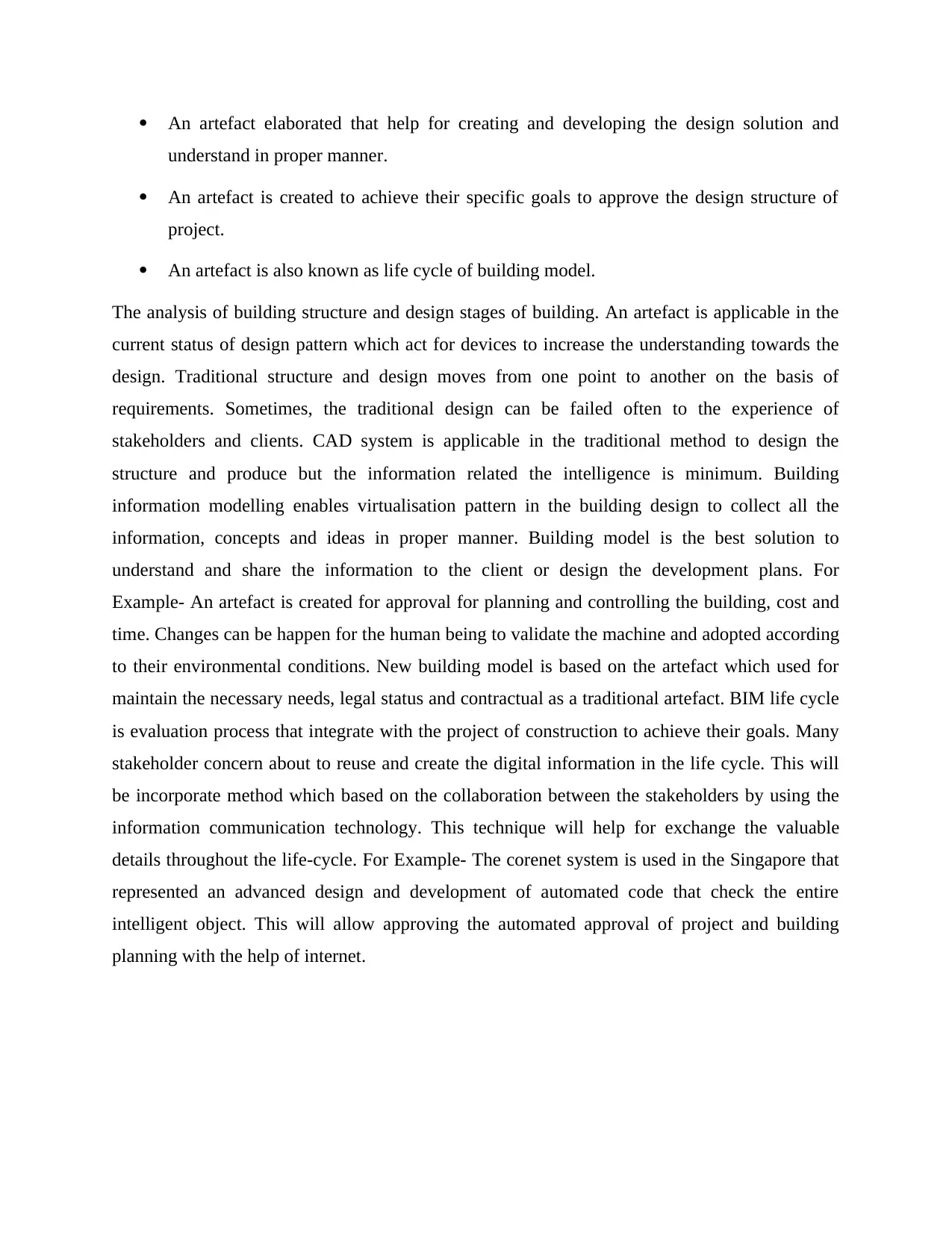
An artefact elaborated that help for creating and developing the design solution and
understand in proper manner.
An artefact is created to achieve their specific goals to approve the design structure of
project.
An artefact is also known as life cycle of building model.
The analysis of building structure and design stages of building. An artefact is applicable in the
current status of design pattern which act for devices to increase the understanding towards the
design. Traditional structure and design moves from one point to another on the basis of
requirements. Sometimes, the traditional design can be failed often to the experience of
stakeholders and clients. CAD system is applicable in the traditional method to design the
structure and produce but the information related the intelligence is minimum. Building
information modelling enables virtualisation pattern in the building design to collect all the
information, concepts and ideas in proper manner. Building model is the best solution to
understand and share the information to the client or design the development plans. For
Example- An artefact is created for approval for planning and controlling the building, cost and
time. Changes can be happen for the human being to validate the machine and adopted according
to their environmental conditions. New building model is based on the artefact which used for
maintain the necessary needs, legal status and contractual as a traditional artefact. BIM life cycle
is evaluation process that integrate with the project of construction to achieve their goals. Many
stakeholder concern about to reuse and create the digital information in the life cycle. This will
be incorporate method which based on the collaboration between the stakeholders by using the
information communication technology. This technique will help for exchange the valuable
details throughout the life-cycle. For Example- The corenet system is used in the Singapore that
represented an advanced design and development of automated code that check the entire
intelligent object. This will allow approving the automated approval of project and building
planning with the help of internet.
understand in proper manner.
An artefact is created to achieve their specific goals to approve the design structure of
project.
An artefact is also known as life cycle of building model.
The analysis of building structure and design stages of building. An artefact is applicable in the
current status of design pattern which act for devices to increase the understanding towards the
design. Traditional structure and design moves from one point to another on the basis of
requirements. Sometimes, the traditional design can be failed often to the experience of
stakeholders and clients. CAD system is applicable in the traditional method to design the
structure and produce but the information related the intelligence is minimum. Building
information modelling enables virtualisation pattern in the building design to collect all the
information, concepts and ideas in proper manner. Building model is the best solution to
understand and share the information to the client or design the development plans. For
Example- An artefact is created for approval for planning and controlling the building, cost and
time. Changes can be happen for the human being to validate the machine and adopted according
to their environmental conditions. New building model is based on the artefact which used for
maintain the necessary needs, legal status and contractual as a traditional artefact. BIM life cycle
is evaluation process that integrate with the project of construction to achieve their goals. Many
stakeholder concern about to reuse and create the digital information in the life cycle. This will
be incorporate method which based on the collaboration between the stakeholders by using the
information communication technology. This technique will help for exchange the valuable
details throughout the life-cycle. For Example- The corenet system is used in the Singapore that
represented an advanced design and development of automated code that check the entire
intelligent object. This will allow approving the automated approval of project and building
planning with the help of internet.
Paraphrase This Document
Need a fresh take? Get an instant paraphrase of this document with our AI Paraphraser
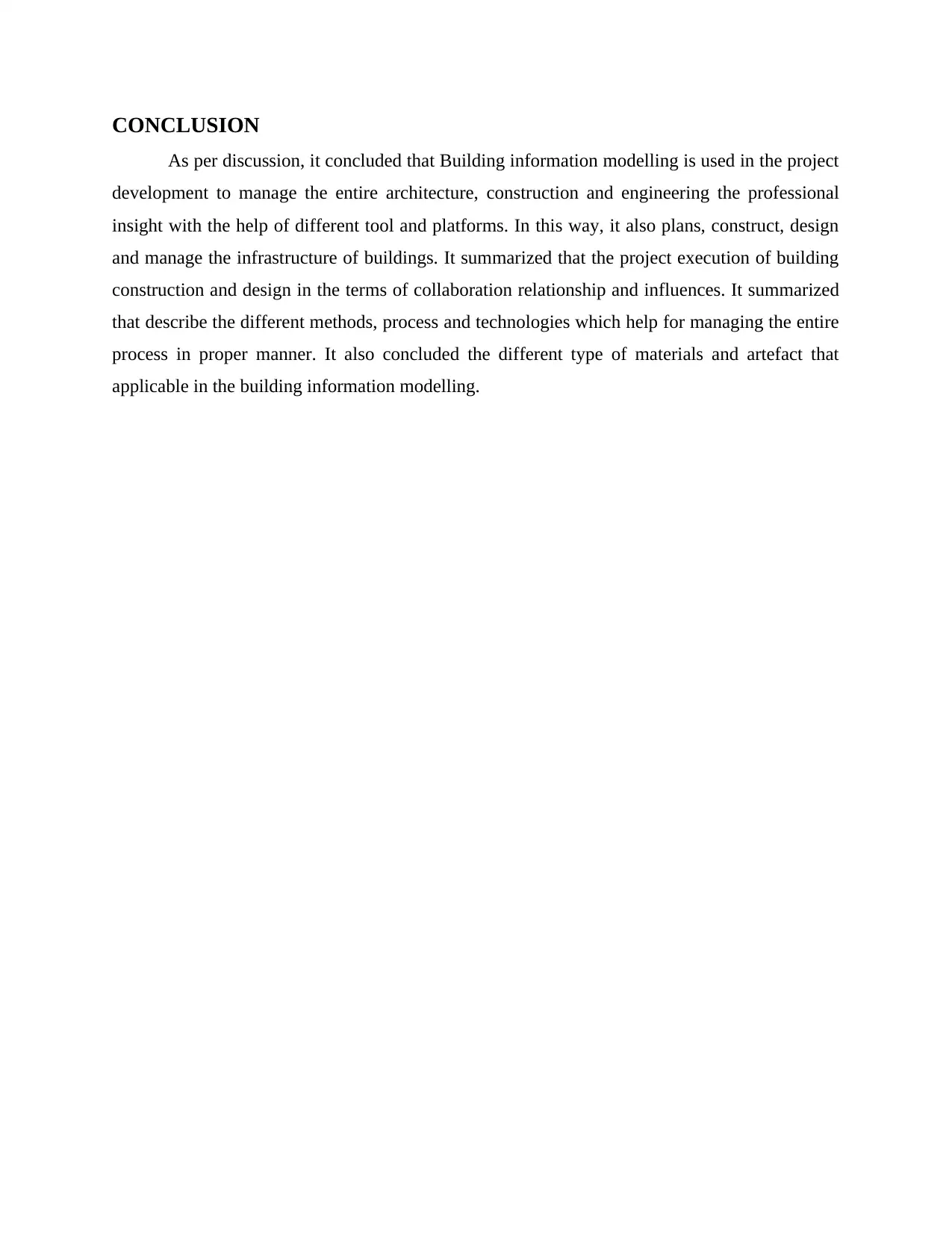
CONCLUSION
As per discussion, it concluded that Building information modelling is used in the project
development to manage the entire architecture, construction and engineering the professional
insight with the help of different tool and platforms. In this way, it also plans, construct, design
and manage the infrastructure of buildings. It summarized that the project execution of building
construction and design in the terms of collaboration relationship and influences. It summarized
that describe the different methods, process and technologies which help for managing the entire
process in proper manner. It also concluded the different type of materials and artefact that
applicable in the building information modelling.
As per discussion, it concluded that Building information modelling is used in the project
development to manage the entire architecture, construction and engineering the professional
insight with the help of different tool and platforms. In this way, it also plans, construct, design
and manage the infrastructure of buildings. It summarized that the project execution of building
construction and design in the terms of collaboration relationship and influences. It summarized
that describe the different methods, process and technologies which help for managing the entire
process in proper manner. It also concluded the different type of materials and artefact that
applicable in the building information modelling.
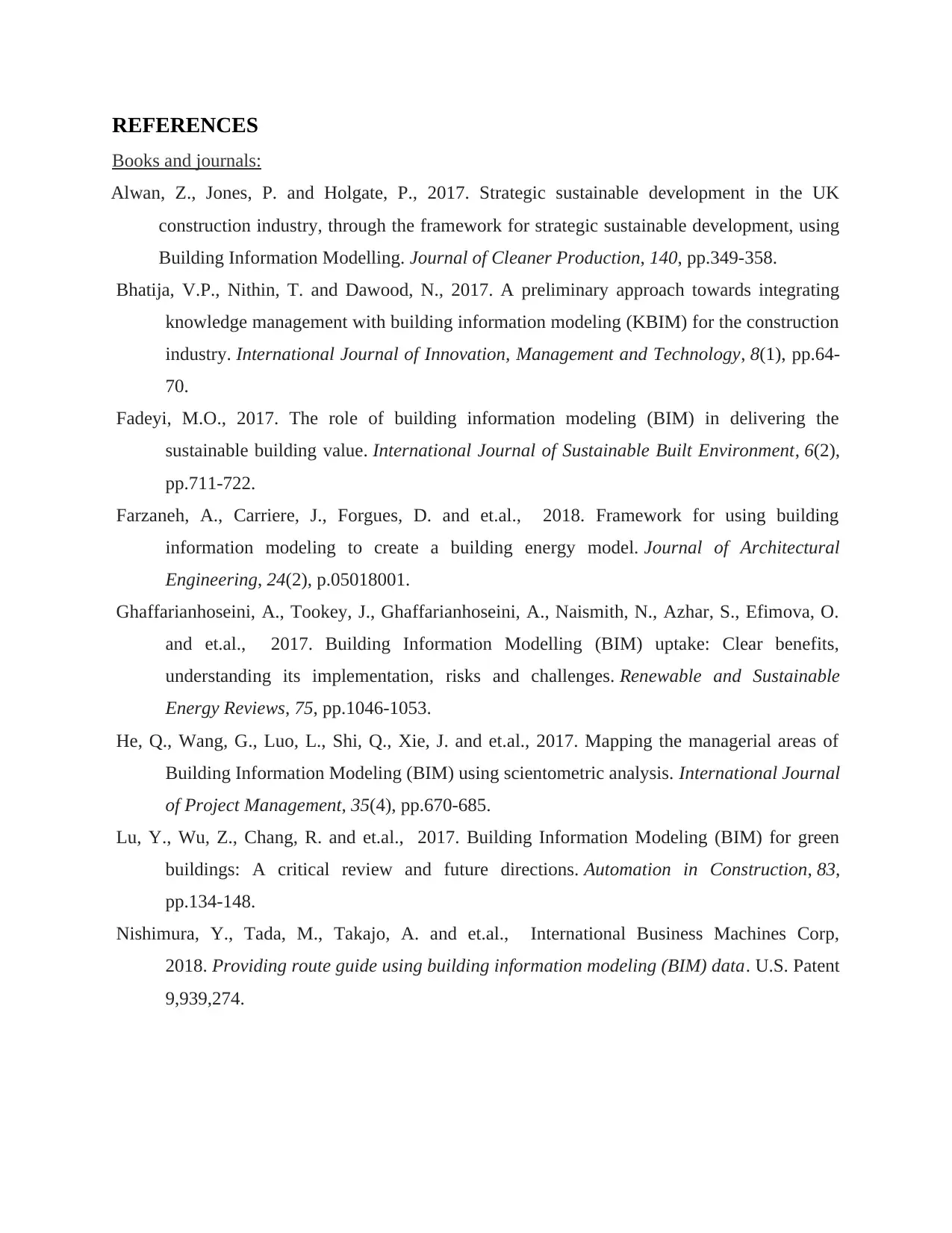
REFERENCES
Books and journals:
Alwan, Z., Jones, P. and Holgate, P., 2017. Strategic sustainable development in the UK
construction industry, through the framework for strategic sustainable development, using
Building Information Modelling. Journal of Cleaner Production, 140, pp.349-358.
Bhatija, V.P., Nithin, T. and Dawood, N., 2017. A preliminary approach towards integrating
knowledge management with building information modeling (KBIM) for the construction
industry. International Journal of Innovation, Management and Technology, 8(1), pp.64-
70.
Fadeyi, M.O., 2017. The role of building information modeling (BIM) in delivering the
sustainable building value. International Journal of Sustainable Built Environment, 6(2),
pp.711-722.
Farzaneh, A., Carriere, J., Forgues, D. and et.al., 2018. Framework for using building
information modeling to create a building energy model. Journal of Architectural
Engineering, 24(2), p.05018001.
Ghaffarianhoseini, A., Tookey, J., Ghaffarianhoseini, A., Naismith, N., Azhar, S., Efimova, O.
and et.al., 2017. Building Information Modelling (BIM) uptake: Clear benefits,
understanding its implementation, risks and challenges. Renewable and Sustainable
Energy Reviews, 75, pp.1046-1053.
He, Q., Wang, G., Luo, L., Shi, Q., Xie, J. and et.al., 2017. Mapping the managerial areas of
Building Information Modeling (BIM) using scientometric analysis. International Journal
of Project Management, 35(4), pp.670-685.
Lu, Y., Wu, Z., Chang, R. and et.al., 2017. Building Information Modeling (BIM) for green
buildings: A critical review and future directions. Automation in Construction, 83,
pp.134-148.
Nishimura, Y., Tada, M., Takajo, A. and et.al., International Business Machines Corp,
2018. Providing route guide using building information modeling (BIM) data. U.S. Patent
9,939,274.
Books and journals:
Alwan, Z., Jones, P. and Holgate, P., 2017. Strategic sustainable development in the UK
construction industry, through the framework for strategic sustainable development, using
Building Information Modelling. Journal of Cleaner Production, 140, pp.349-358.
Bhatija, V.P., Nithin, T. and Dawood, N., 2017. A preliminary approach towards integrating
knowledge management with building information modeling (KBIM) for the construction
industry. International Journal of Innovation, Management and Technology, 8(1), pp.64-
70.
Fadeyi, M.O., 2017. The role of building information modeling (BIM) in delivering the
sustainable building value. International Journal of Sustainable Built Environment, 6(2),
pp.711-722.
Farzaneh, A., Carriere, J., Forgues, D. and et.al., 2018. Framework for using building
information modeling to create a building energy model. Journal of Architectural
Engineering, 24(2), p.05018001.
Ghaffarianhoseini, A., Tookey, J., Ghaffarianhoseini, A., Naismith, N., Azhar, S., Efimova, O.
and et.al., 2017. Building Information Modelling (BIM) uptake: Clear benefits,
understanding its implementation, risks and challenges. Renewable and Sustainable
Energy Reviews, 75, pp.1046-1053.
He, Q., Wang, G., Luo, L., Shi, Q., Xie, J. and et.al., 2017. Mapping the managerial areas of
Building Information Modeling (BIM) using scientometric analysis. International Journal
of Project Management, 35(4), pp.670-685.
Lu, Y., Wu, Z., Chang, R. and et.al., 2017. Building Information Modeling (BIM) for green
buildings: A critical review and future directions. Automation in Construction, 83,
pp.134-148.
Nishimura, Y., Tada, M., Takajo, A. and et.al., International Business Machines Corp,
2018. Providing route guide using building information modeling (BIM) data. U.S. Patent
9,939,274.
⊘ This is a preview!⊘
Do you want full access?
Subscribe today to unlock all pages.

Trusted by 1+ million students worldwide
1 out of 14
Related Documents
Your All-in-One AI-Powered Toolkit for Academic Success.
+13062052269
info@desklib.com
Available 24*7 on WhatsApp / Email
![[object Object]](/_next/static/media/star-bottom.7253800d.svg)
Unlock your academic potential
Copyright © 2020–2025 A2Z Services. All Rights Reserved. Developed and managed by ZUCOL.




